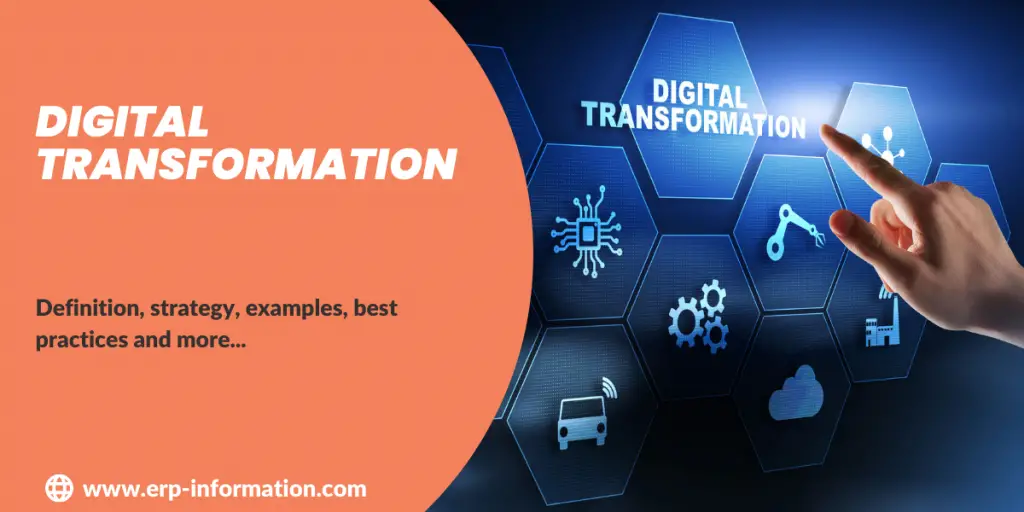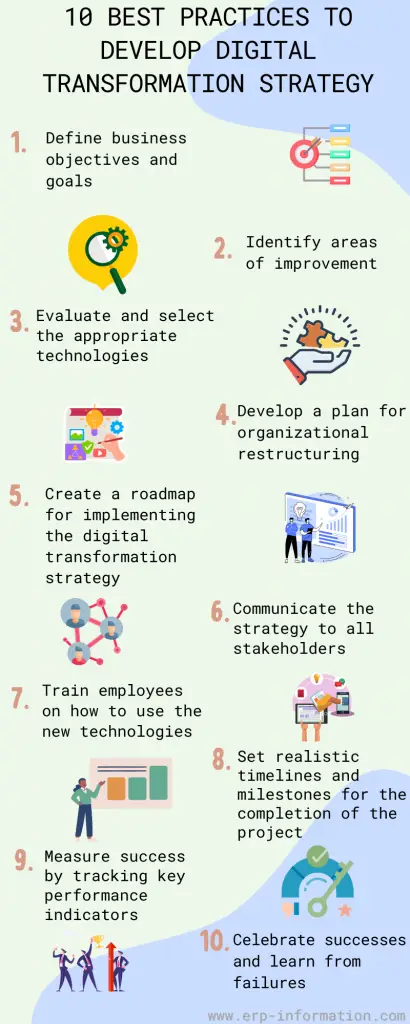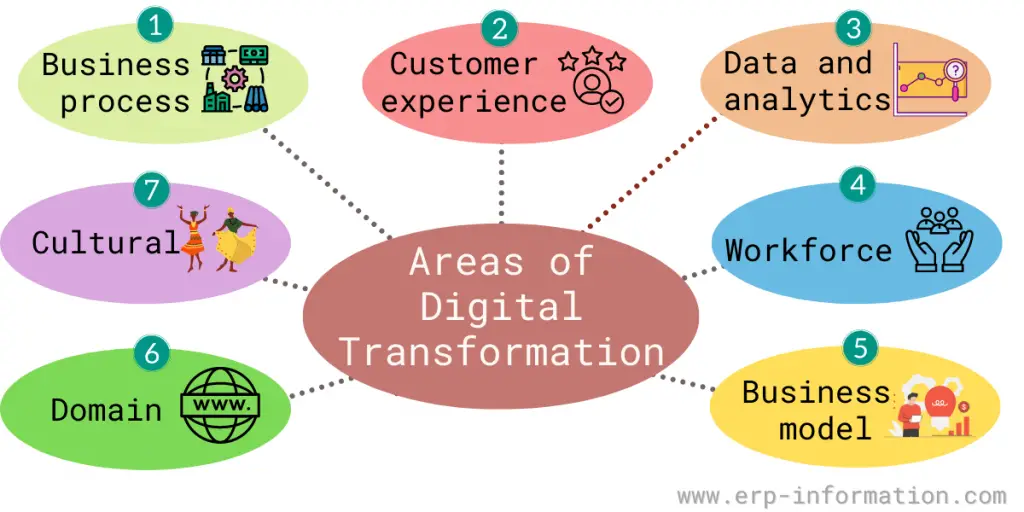Digital transformation, also called DX, is one of the essential issues companies face today. How we do business is changing, and if your company wants to stay competitive, you must make sure you are switching to digital.
This article will discuss digital transformation, its strategies, best practices, and some examples of companies that have successfully completed a DX.
What is Digital Transformation?
It is the process of transitioning from legacy business models to new digital business models. That means your business no longer relies on traditional methods of operation, such as paper documents and in-person meetings.
Instead, it depends on digital technologies to support its day-to-day activities. It integrates digital technologies and new business models in all business areas, including business processes, structure, culture, and customer experience.
Digital transformation strategy
It is a plan for how an organization will use technology to change its operations. It includes initiatives such as developing new customer-centric business models, implementing innovative marketing campaigns, redesigning processes, and adopting new technologies.
The strategy should include goals, objectives, and actions to help the organization achieve its desired outcomes.
It’s important to have a clear strategy before beginning transformation, as this will help ensure everyone involved is on the same page and knows what’s expected of them.
Best practices
1. Define business objectives and goals for digital transformation
First, you need to define what your company wants to achieve. For example, does it want to improve the customer experience, increase efficiency, reduce costs, boost revenue/sales, enter new markets, etc.?
If you’re unsure where to start, try looking at your company’s current pain points and brainstorming ways.
2. Assess your current state and identify areas of improvement
Once you know your goals, you must take a step back and assess your company’s current state. That will help you identify opportunities for improvement and where digital transformation can have the most significant impact.
That includes
- Your company’s organizational structure
- Business processes
- IT Infrastructure
- Employee skills and training
- Customer experience
If you’re unsure where to start, try conducting a SWOT analysis. That helps you determine your company’s strengths, weaknesses, opportunities, and threats.
Once you’ve identified areas of improvement, you can begin developing a plan for how to address them.
3. Evaluate and select the appropriate technologies to support the transformation
One of the most critical aspects is choosing the right technologies to support transformation. There are many different options out there, so it’s vital to take the time to evaluate each one and select the ones that will best help you achieve your goals.
Some standard technologies used in DX initiatives include:
- Cloud computing
- Big data and analytics
- Mobile apps and websites
- Social media
- Automation
4. Develop a plan for organizational restructuring, if necessary
In some cases, digital transformation will require organizational restructuring. That is often necessary to align the company’s structure with its new goals and objectives.
If you decide that organizational restructuring is necessary, you’ll need to develop a plan for how to do it.
5. Create a roadmap for implementing the digital transformation strategy
Once you’ve developed your transformation strategy, you need to create a roadmap for how to implement it. That should include things like:
- Defining roles and responsibilities
- Creating timelines and milestones
- Establishing KPIs and measures of success
- Allocating resources
Executing a transformation initiative can be a complex and daunting task. However, by following these steps, you can develop a clear and actionable plan to help ensure your success.
6. Communicate the strategy to all stakeholders and ensure buy-in from key decision-makers
Once you’ve developed your strategy, it’s important to communicate it to all stakeholders. That will help ensure everyone is on the same page and buy-in from key decision-makers.
7. Train employees on how to use the new technologies and tools required for the transformation
One of the most important aspects is ensuring that employees are adequately trained to use the new technologies and tools required for the transformation. That will help ensure they can effectively support the initiative and contribute to its success.
8. Manage expectations by setting realistic timelines
It’s essential to manage expectations by setting realistic timelines and milestones for project completion. That helps to ensure that the project stays on track.
9. Measure success by tracking key performance indicators (KPIs)
Measuring success is essential. By monitoring key performance indicators (KPIs), you can ensure that the initiative is on track and progressing towards its goals.
10. Celebrate successes along the way and learn from any failures
Digital transformation is a journey, and it’s important to celebrate successes along the way. Additionally, it’s also essential to learn from failures to avoid making the same mistakes in the future.
This journey requires long-term planning and commitment. We can’t achieve it overnight.
Digital transformation examples
- The way that Amazon has completely reinvented the way that people shop
- Uber‘s impact on the taxi industry
- How Netflix has changed how people watch TV and movies
- How banks have changed the banking transaction system from in-person to ATM transactions and net banking.
- The communication field shifted from fax to email
- Usage of 3D printing in the automotive industry
What are the areas of digital transformation?
- Business process: It involves redesigning and automating business processes to improve efficiency and effectiveness.
- Customer experience: It involves designing and delivering engaging and personalized customer experiences across all touchpoints.
- Data and analytics: It involves harnessing the power of data to drive insights, decision-making, and actions.
- Workforce: The workforce involves rethinking how work gets done and designing new ways to empower and motivate employees.
- Business model – It involves designing and implementing new business models that are agile, customer-centric, and data-driven.
- Domain – It involves rethinking and redesigning traditional business domains such as marketing, sales, finance, HR, etc., which are customer-centric, data-driven, and agile.
- Cultural –This involves creating a culture of innovation and experimentation that is open to change and willing to welcome new technologies and ways of working.
FAQs
What is the digital transformation framework?
It is a comprehensive guide for planning and executing digital transformation initiatives.
It includes a five-phase process for assessing, designing, implementing, measuring, and optimizing DX. The framework also consists of resources and tools organizations can use to facilitate DX.
What are the benefits of digital transformation?
There are many benefits, including
– Increased efficiency and productivity
– Improved customer experience and engagement
– Increased revenue and market share
– Reduced costs and improved profitability
– Improved employee satisfaction and retention.
What are some challenges of digital transformation?
-Implementation and integration challenges
-Change management challenges
-Data security and privacy concerns
-Talent acquisition
Conclusion
Digital transformation is a comprehensive process for planning and executing changes to an organization’s digital capabilities. The benefits include increased efficiency, productivity, customer engagement, and profitability.
Despite some challenges, its benefits make it a worthwhile endeavor for many organizations.
By taking a strategic and comprehensive approach to DX, organizations can overcome these challenges and reap the many benefits of this transformative process.
Reference
Developing Digital Transformation Strategy for Manufacturing


